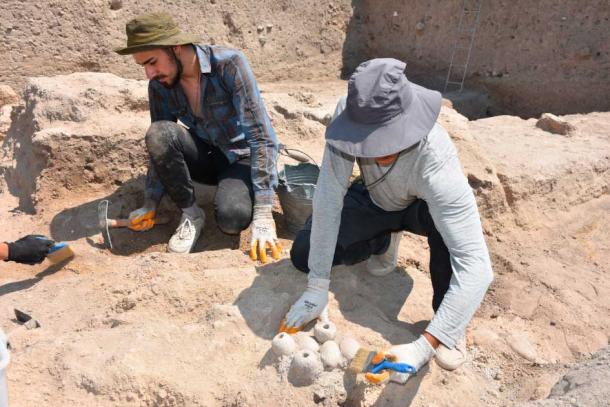7,800-year-old Female Figurine Found at Anatolia’s Ulucak Mound
One of the most prominent and oldest Neolithic sites found in what is now Turkey has yielded yet another interesting find – a clay statuette of a female figurine has been unearthed in Izmir, dated to 7,800 years ago. The find, made in the Ulucak Höyük or Ulucak Mound, one of the oldest sites in Western Anatolia, located in the Kemalpasa district of the western Turkish province. It has been described as “a very rare piece”, possibly used in important rituals of life and death.
The Feminine Mystique and the Ulucak Mound
The female figurine is thought to be used in rituals of fertility and prayers to the divine for a good harvest. What is interesting is that previously such figurines have been discovered dumped in the ancient garbage, indicating that they were not sacred, but used for the ceremony and then their utility was likely spent.
According to the archaeologists working on the site, the female figurine could have been used in the rituals of birth and death, and even potentially as totems of magic, but more research is required to ascertain this particular figurine’s utility.
Excavation director and Trakya University faculty, Professor. Dr. Özlem Çevik, who had taken charge in 2009 said that:
“During the excavations of a house this year, we found a whole female figurine made of clay. We have identified such figurines before… But we usually find it broken. This figurine is important to us as it is the third complete figurine we have ever found in Ulucak Mound. It is a very rare work."
- Praying For Life – Top 10 Ancient Fertility Goddesses
- 11-Year-Old Boy Finds Rare Ancient Fertility Goddess Amulet In Israel

Archaeologists work in the Ulucak Mound, Izmir, Turkey. (Anadolu Agency)
An Ancient Western Anatolian Site
The mound, under excavation since the mid-1990s, is 8,850 years old. This is reportedly the first find of the year, according to Turkish state media, Anadolu Agency. It has been supported by the Turkey Ministry of Culture and Tourism, İzmir Metropolitan Municipality, Kemalpaşa Municipality, and Kemalpaşa Organized Industrial Zone, all keen to aid in the recognizing the cultural heritage of the region.
This assumes even more importance when it is considered that the Ulucak Mound hosted the first farmers of the Aegean region. In fact, the first settlers here built their houses on top of each other along the 7.5 meter (24.6 feet) cultural layer. Here, they settled for almost 1,200 years without interruption, leaving behind valuable traces of their existence.
Three distinct layers of human existence have been identified at the mound, reports Arkeo News. These include the Late Roman period and Early Byzantine settlements, the Early Bronze Age layers stacked underneath, and then late Neolithic settlements at the bottom. In these excavations, ceramic pots, ganister tools, stone weapons, mother goddess figurines, and anthropomorphic pots have been unearthed, exhibited in the Izmir Archaeological Museum.
- Who Were the Mysterious Neolithic People That Enabled the Rise of Ancient Egypt?
- 4,500-year-old Megalithic Super-Henge Found Buried One Mile from Stonehenge
From Makeshift to Mudbrick: Early Settlements and Human Coexistence
Another co-worker on the excavation, Prof. Dr. Agile said, “With the Ulucak Mound excavations, not only Izmir but also Western Anatolia was inhabited 8,850 years ago. These excavations are important because they take the history of İzmir back over 8,500 years.”
The region is located on a fertile plain - a key location. The layer of the first settlers reveals it was then inhabited continuously for 1150 years. It is also important in terms of showing how the first farmers of Izmir were transformed in terms of settlement and society after settling. Architecturally, the first houses were built with the fence and mud technique.

Many layers of excavation have taken place at Ulucak Höyük. (Kemelpasa District Governorship)
He further elaborated on this by explaining that in this very early period of settled human history, the transition was already being made to accommodate a ‘high-intimacy structure’. Makeshift architecture now paved way for mudbrick architecture with stone foundations, signaling an intent to stay, rather than move after a while.
This was followed by the coming of the courtyards, structures which allowed human beings in small settlements and communities to congregate. Congregation was what allowed certain events and rituals and festivals to be celebrated.
The walls were pulled down and streets come into place that create a demarcation between various homes, without necessitation of a notion of private property. Whilst the transition to a public, communitarian setup was happening, at the same time, there was also a huge scope for privacy that was being articulated through the emerging architectural style. This has been one of the key takeaways from the current find.
Top image: The latest find of a 7,800-year-old female figurine in Ulucak Mound, Turkey. Source: Anadolu Agency
By Sahir Pandey
References
Agency Anadolu. 2022. 7,800-year-old female figurine found in Türkiye's Izmir. Available at: https://www.dailysabah.com/life/history/7800-year-old-female-figurine-found-in-turkiyes-izmir
TPN. 2022. 7,800-year-old female figure figurine found in Izmir. Available at: https://turkey.postsen.com/news/79552/7800-year-old-female-figure-figurine-found-in-Izmir.html




















Comments
Looks like it was made for interchangeable heads. The spice of life?
Nobody gets paid to tell the truth.
It'd be really interesting to find out what future archaeologist would make of all the crap that we throw away.... XD would our discarded things be attached an assumption of religious significance too?
infinitesimal waveparticles comprise what we call home the earth
manipulatable by thought ability supressed in humans since birth